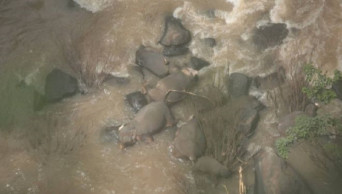Animals
3 bald eagles die, 10 sick after eating euthanized animals of Minnesota landfill
At least 13 bald eagles were likely poisoned by scavenging the carcasses of euthanized animals that were improperly dumped at a Minnesota landfill, and three of the majestic birds have died.
The Minneapolis Star Tribune reports that state and federal wildlife officials are investigating after the eagles were found this month near the Pine Bend Landfill in the Minneapolis suburb of Inver Grove Heights.
Read more: Oldest DNA reveals life in Greenland 2 million years ago
Ten of the birds are in intensive care at the University of Minnesota Raptor Center. The center's executive director Victoria Hall said she is optimistic those birds will recover.
Hall said when the eagles were found some of them were lying motionless, face down in the snow, and Raptor Center workers weren't sure if they were still alive. Veterinarians suspect that the eagles that died had eaten part of a carcass of an animal that had been euthanized with pentobarbital, and investigators confirmed that some euthanized animals had been brought to the landfill on Dec. 2.
Hall said animals that have been chemically euthanized are supposed to be disposed of in such a manner that other animals can’t scavenge on them.
Read more: Beloved monarch butterflies now listed as endangered
Of the 11 eagles that were brought to The Raptor Center, three also had lead poisoning and one eagle that was found to have bird flu died. Two other eagles were found dead near the landfill.
A fund has been set up to help pay for the eagles' care.
3 years ago
Light pollution in Bangladesh: A big blow to nature
Great writers are said to be night owls as they find the night more productive than the day even though there are debates over body rhythms and the writing process.
“I often think that the night is more alive and more richly coloured than the day,” says Vincent Van Gogh, a Dutch post-impressionist painter, while Mahatma Gandhi, a great Indian political philosopher, says, “In the midst of darkness, light persists.”
But today it is nearly impossible to find natural darkness even at night. This is not good, not good at all, said experts.
They stressed the need for raising awareness against the nighttime excessive artificial lighting in Dhaka, considering its dire impacts on the biological clock of the human bodies and lives of other animals including birds, bugs and insects that navigate based on light.
Read:Experts lament lack of steps to check air pollution in Dhaka city
Though light pollution is a new phenomenon in the country, some major cities in the world have started acting against the nighttime excessive lighting as it badly affects the mental and physical health of the humans and the lives of other animals, they said.
Alongside controlling air, noise and other environmental pollution, the authorities concerned should now think about the nighttime light pollution also to protect public health and ecosystem as well as save electricity by limiting excessive outdoor lighting, the experts said.
Most recently, a video has gone viral on the social media that some sparrows took shelter inside a house in Dhaka, being frightened by excessive lightings and sounds generated by fireworks and Fanus (sky lantern) during the 31st night celebrations.
Public health expert Dr MH Chowdhury Lelin said every animal leads its life through a circadian clock, but the light pollution changes the biological clock keeping serious impacts on mental and physical health.
“The excessive lighting causes an overstimulated nervous system, headache, sleeplessness, high blood pressure, high heartbeat, irritable mood and vision power of a man. So, it ultimately hampers the normal activities of a human body and one’s mental health,” he said.
Dr Lelin, also an environmental activist, said the nighttime excessive lighting hampers the sleeping pattern of the human and most birds and other wildlife which badly affect their normal lives during the day.
Besides, he said, the nighttime artificial lighting severely affected the nocturnal animals that they can’t intake foods due to the light pollution. Even the nighttime lighting has an adverse impact on plants. So, the light pollution affects the whole ecosystem.
The excessive indoor lighting despite having enough light during the daytime is also considered light pollution, said Dr Lelin.
Biomedical scientist and educationist Prof Dr Liaquat Ali said the light pollution can elicit melatonin suppression, though the hormone acts as an antioxidant.
“If the melatonin secretion declines, it damages its antioxidant effect, disturbs biological clock and immunity. So, the light pollution may cause different diseases like obesity, diabetes and cancer,” he said.
It also has adverse impacts on mental health, creating depression and disturbing sleep pattern, said Dr Liaquat Ali.
3 years ago
Message to Zoo Visitors: Don't feed the Wildlife your food for the good of both you and them
Animals play a significant role in the ecosystem by maintaining the balance of the environment. In addition to the country's sanctuaries, the zoos are supposed to take proper measures to provide food for the health of the animals. Even then, it is often seen that visitors at the zoo try to feed the animals their own food, which can have detrimental effects on both animals and visitors. Let's find out the reasons not to feed the animals your food at the zoo.
Why you shouldn’t feed the animals your food at the zoo
Breaking dietary control
You will be surprised to know that animals are kept on a specific diet based on their species at the zoo. Generally, critters’ digestive system is very sensitive as they take time to evolve with the food they are given. At the zoo, they are trained to systematically cope with the food they are given. Therefore, human food, in this case, becomes a new thing for them to adapt to.
Eventually, they can keep rejecting their daily food due to random taking in despite the timetable. This can lead to a decline in their ability to survive.
Moreover, some human food is full of additives including sodium and sugars. You often take high processed fried and spicy food, sugary drinks, sausages, and alcohol at the zoo. These are very poisonous to critters. This would cause some severe health issues.
A deformity called "angel wing" is often seen in geese and ducks who are regularly fed white crackers, bread, and popcorn. Moreover, a diet that is good for you can pose a serious risk to animals, especially young ones, who need certain nutrients as they grow older.
Read:Post pandemic wanderlust list: Best international destinations to travel
Damaging reproduction system
Everyday artificial feeding can push animals into unbalanced reproduction. By stopping feeding, you can cut off the supply of those artificial foods to the animals. This may prevent the animal from relying on natural resources for additional breeding. Reproductive imbalances affect not just one species, but an entire ecosystem, leading to unintended environmental consequences.
In the case of pregnant animals, it is difficult to give birth. In many cases, the baby critter may even die at birth.
Suffering from various diseases
The zookeepers may have to deal with various diseases which lead them to emergency treatment for animals. Starting from a general bad feeling to a big disease like diarrhea even death in the ultimate case can occur. Like a human, critters also have stomach bugs. It can happen from any type of inappropriate food you give them.
The horrible thing is that a health issue named bloat happens to Ruminate species of animals like Giraffe that eat too many wrong types of foods. It happens when the rumen pH inside them becomes inconsistent. Accordingly, the foods in their stomach are getting fermented. Foods then start to be foam which in turn can’t pass the gases away. As a result, diarrhea and sometimes even death can occur within a few hours if it is in an acute state.
Read UAE becomes world’s most vaccinated nation against COVID-19: Bloomberg's Vaccine Tracker
Moreover, a stick or leaves can also be harmful to animals. You must know that plants have tannins, a natural compound that helps protect them from prey. Tannic acid, produced by these plants in huge quantities, can lead to nausea, stomach irritation, liver damage, and vomiting.
4 years ago
China’s wandering elephants may finally be heading home
An elephant herd that fascinated locals and people around the world by making a yearlong journey into urbanized southwest China, raiding farms and even a retirement home for food, appears finally to be headed home.
Local authorities have deployed trucks, workers and drones to monitor the elephants, evacuated roads for them to pass safely and used food to steer them away from populated areas. Despite their entrance into villages and a close approach to the Yunnan provincial capital of Kunming, no animals or humans have been injured.
Read: 2 elephants that crossed from Myanmar rescued from Bay
The 14 Asian elephants of various sizes and ages were guided across the Yuanjiang river in Yunnan on Sunday night and a path is being opened for them to return to the nature reserve where they lived in the Xishuangbanna Dai Autonomous Prefecture.
The elephants left the reserve more than a year ago for unknown reasons and roamed more than 500 kilometers (300 miles) north. After reaching the outskirts of Kunming, a center for business and tourism, they turned south again, but still are far from the reserve.
One male that separated from the herd was subsequently tranquilized and returned to the reserve.
Asian elephants are among the most highly protected animals in China and their population has grown to around 300, even while their habitat has shrunk because of expanded farming and urban growth.
As of Sunday night, the herd was still in Yuanjiang County, approximately 200 kilometers (125 miles) from the reserve.
Read: Don t gawk or give food: Wandering elephants near China city
However, the National Forestry and Grassland Administration said the animals were in a “suitable habitat” after crossing the river.
A notice issued by provincial government said the herd’s progress was significant and it would continue to work on getting the elephants back in their natural habitat soon.
4 years ago
Six elephants die trying to save each other at Thai waterfall
Dhaka, Oct (UNB) - Six elephants have fallen to their deaths in Thailand while trying to save each other from a notorious waterfall.
6 years ago






